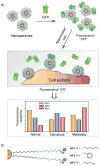Surface functionalization of nanoparticles for nanomedicine
- PMID: 22310807
- PMCID: PMC4102397
- DOI: 10.1039/c2cs15294k
Surface functionalization of nanoparticles for nanomedicine
Abstract
Control of interactions between nanoparticles and biosystems is essential for the effective utilization of these materials in biomedicine. A wide variety of nanoparticle surface structures have been developed for imaging, sensing, and delivery applications. In this research Highlight, we will emphasize advances in tailoring nanoparticle interfaces for implementation in nanomedicine.
Figures





References
-
- Daniel MC, Astruc D. Chem Rev. 2004;104:293–346. - PubMed
-
- Redl FX, Black CT, Papaefthymiou GC, Sandstrom RL, Yin M, Zeng H, Murray CB, O’Brien SP. J Am Chem Soc. 2004;126:14583–14599. - PubMed
-
- Chou LY, Ming K, Chan WC. Chem Soc Rev. 2011;40:233–245. - PubMed
-
- Elghanian R, Storhoff JJ, Mucic RC, Letsinger RL, Mirkin CA. Science. 1997;277:1078–1081. - PubMed
Publication types
MeSH terms
Substances
Grants and funding
LinkOut - more resources
Full Text Sources
Other Literature Sources

